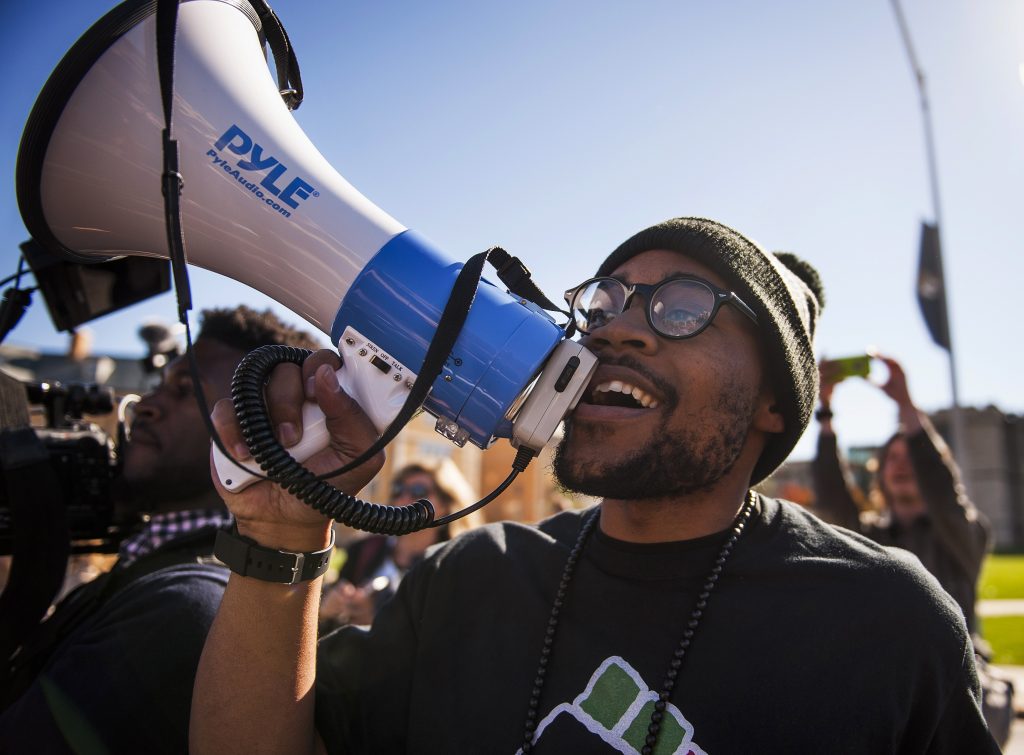The Myth of Free Speech

Among the critiques of anti-racist activism on U.S. campuses, none is more misguided than the case for unfettered free speech.
Protesters such as hunger striker Jonathan Butler at the University of Missouri have argued that “a campus where people feel free to call people the n-word” cannot offer students of color an environment where they can focus on their education. Such arguments led columnist George Will to quip that Butler and his colleagues “cut class the day the First Amendment was taught.” As Will saw it, acceding to those students’ demands would “guarantee not freedom of speech but freedom from speech.”
But the First Amendment says merely that “Congress shall make no law … abridging the freedom of speech.” Since congressional laws are not at stake in the campus controversy, Will’s conception of free speech seems to be that in the United States, anyone has the right to say anything at any time. And while this is manifestly untrue (legally, you cannot yell “fire” in a movie theater, and teachers have a right to maintain “classroom order” by regulating speech), it reflects, accurately enough, a commonsense understanding of free speech.
In the current debate about racist language on university campuses, those who denounce the student protesters in the name of free speech misrepresent how language really works.
But this conception is a myth, because it treats speech as a “freedom,” a thing citizens “possess,” rather than an ongoing and omnipresent activity structured by grammatical and social rules.
To be understood, speakers must follow the grammatical rules of the language used in their community. A speaker can usually disregard one or more grammatical rules in a sentence and still be understood. For example, most American English speakers would understand a person who says, “feet my are cold.” But a person who breaks too many grammatical rules will become incomprehensible (“cold my are feet”).
Beyond the rules of grammar there are rules governing the social use of language. We start teaching our children these rules from the moment they begin to talk. “Don’t use that word at the dinner table,” “do not take God’s name in vain,” and so on. We have all absorbed so many of these rules over time that we are almost always “polite,” whether we are aware of it or not. There are many things we will not permit ourselves to say in many contexts, a state of affairs we routinely accept.
It is important to recognize that rules of politeness vary by cultural context and change over time. What was once speakable can become unspeakable, and vice versa. For example, when I arrived at the University of Virginia in 1986, it was customary at football games for many people in the crowd to mock the word “gay” in the school song. “We come from old Virginia/Where all is bright and gay”—the singing of these phrases brought a boisterous, semiorganized response of “Not gay!” in the musical pause that precedes the next line of the song. But in the 1990s, university groups devoted to gay rights began campaigning to challenge this tradition, which has gradually disappeared. Today, people no longer feel “free” to use a public ritual in a way that is insulting to an important part of our community, and the vast majority of the community prefers it that way (although there are exceptions—which are swiftly censured).
To say that the students who campaigned to do away with “Not gay!” violated the free-speech rights of members of our community is to rely on that commonsensical notion of free speech that is, as I have shown, unrealistic. It is true, of course, that the university tries to be an institution where people can freely speak their minds. But like any “speech community”—a group of speakers who share a set of expectations of how language should be used—university professors and students observe a multitude of rules about who can say what to whom.
In the current debate about racist language on university campuses, those who denounce the student protesters in the name of free speech misrepresent how language really works. This enables them to use the myth of free speech as a proxy to argue against the political arguments the protesters are making. The anti-anti-racism critique (let’s call it what it is!) implies that the current state of affairs, in which racist speech is allowable and defensible, is a state of freedom from rules of speech. But there is no speech community without rules of speech.
Thus the real question that is being debated is this: To what extent is racist speech acceptable in the public spaces of these institutions? If the protesters were to succeed in their aims they would simply be changing the rules of public decorum at their universities, just as protesters at the University of Virginia did with respect to our school song.
But if they fail, it will not mean that the right of free speech has been preserved and protected. It will only mean that one set of rules about what the community deems speakable has won out, for the time being.

































